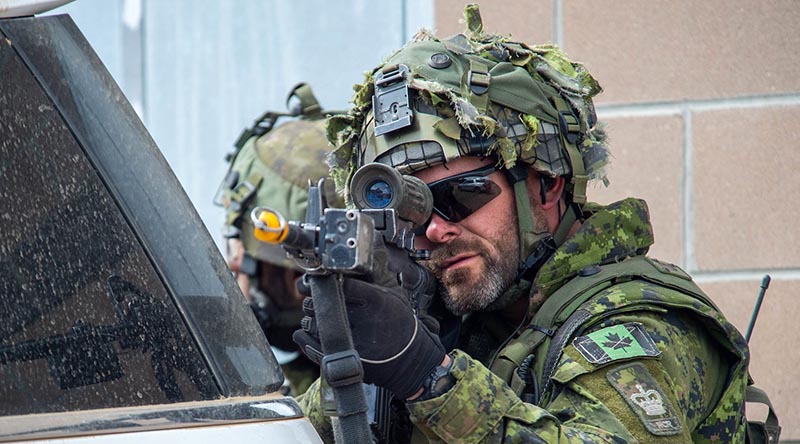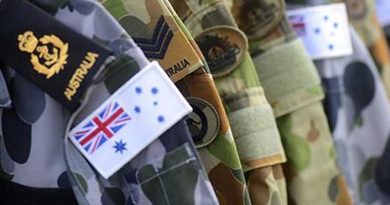Piercings, long hair, facial tattoos allowed under new Canadian Armed Forces dress rules
Share the post "Piercings, long hair, facial tattoos allowed under new Canadian Armed Forces dress rules"

In a bid to open up recruiting to a wider cross-section of society, the Canadian Armed Forces have completed a major overhaul of dress rules, to allow beards, piercings, long and/or coloured hair, face tattoos – even sunglasses on parade!
Canadian Armed Forces photo
Basically, it seems, almost anything goes as long as it is safe and can accommodate operational requirements.
The updated Dress Instructions will take effect in early September 2022.
Canadian Armed Forces headquarters issued the following Q&As to explain the new rules.
Will recruits need to shave their head on basic training?
No, the updated hair policy applies to all CAF members from recruitment to retirement.
Is there a maximum length for hair?
No, there are no restrictions on the length of hair. However, long hair must be tied when extending below the top/ridge of the shoulder or that extends below the service dress collar for ceremonial occasion. It must not prevent the proper wear of headdress and must not impede the visibility of the member’s face. Safety and operational requirements shall be met.
What types of braids are considered acceptable?
Any style braid(s) may be used, as long as it remains in line with safety and operational requirements. Hair must be tied to ensure the headdress can be worn properly and the face is visible. A bun, braids, or ponytail are examples of appropriate ways to tie the hair.
Is unnatural-coloured hair acceptable in ceremonial orders of dress? And must accessories match the colour of hair?
Yes, the colouring of hair is permitted in all orders of dress unless it inhibits an operational duty. For example, bright coloured hair may have a negative operational impact during field operations or training. Leaders are invited to discuss with their members to find a simple, suitable accommodation, such as a scarf to cover the hair. Accessories do not have to match the colour of the member’s hair. However, all accessories shall meet safety and operational requirements and not must not discredit the CAF.
Is there any change on the beard policy?
Yes, the wearing of sideburns, beards, moustaches and goatees, or combination of style, is authorized for all members of the CAF from recruitment to release. There is no maximum or minimum length. Only, they must be kept neatly groomed and symmetrical in style while always complying with safety requirements and operational requirements.
Can CAF members be asked to shave their facial hair?
Yes, Commanders of Commands, Task Force Commanders, Formation Commanders and Commanding Officers retain the right to order restrictions on the wearing of facial hair to meet safety and operational requirements. This instruction does not supersede Federal or National safety codes or regulations.
Since multiple facial hair styles are approved, must a person request a period of transition for each change in facial hair?
No, as long as it is neat and evenly trimmed. For example, a member going from a goatee to a full beard should shave down the goatee so facial hair appears evenly and symmetrically trimmed.
Are tattoos on the face permitted? And what is considered the face?
The face is the front part of the head that extends from the forehead to the chin and from the anterior part of one ear to the other. Tattoos are permitted on the face as long as they conform to the regulations outlined in Section 2 – Appearance. “Tattoos that the member knows, or ought to know, are associated with criminal activities (e.g. criminal gangs), tattoos that promote and/or express, on the basis of a prohibited ground of discrimination as defined in the Canadian Human Rights Act (CHRA), the following: hatred, violence, discrimination, or harassment: and tattoos that a CAF member knows, or ought to know, promote and/or express: racism, sexism, misogyny, xenophobia, homophobia, ableism, or sexual explicit material” are not permitted.
Are hoops and long earrings acceptable in uniform?
Yes, ear piercings, hoops and spacers are authorized but can be no more than 2.5 cm in length from the bottom of the ear. Safety and operational requirements must always be met. Spacers must not extend 2.5 cm in diameter. In all ceremonial orders of dress (No. 1), only one single stud type (one in each ear) is permitted in the lobe not to exceed 1 cm.
What jewelry is acceptable for ceremonial orders of dress?
The following is acceptable:
- Rings: a maximum of two rings which are not of a costume jewellery nature. Additional rings may only be worn when they indicate professional standing, such as an engineer, or are worn with a wedding band as a single set indicating betrothal or fidelity, e.g., an engagement or an anniversary ring. Rings shall not inhibit the execution of proper arms drill or cause an unsightly bulge in white or black gloves.
- Necklaces and bracelets: shall not be visible;
- Piercings: the only piercing jewellery authorized are single or single set of stud or single stone earrings (one in each ear) in the earlobe(s) only. Piercings are not permitted on the face. Earrings shall not exceed one centimetre square or diameter. Gauges/spacers shall not exceed 2.5 cm in diameter.
- Plain tie-pins or clips or with a Canadian military insignia are permitted.
In operational dress (order of dress 5), is there a limit to the number of ear-piercings that are acceptable?
In general, there are no restrictions unless there is a safety issue or operational effectiveness may be jeopardized.
Following both the jewelry and piercings policy, can two piercings be connected with a chain in one ear?
Yes, as long as both piercings and chain are within 2.5 cm in diameter or length, and safety or operational effectiveness is not compromised. However, only one single stud (max 1 cm) or spacer(max 2.5 cm) per ear is authorized in ceremonial orders of dress (order of dress No. 1).
If a CAF member recently had their upper ear pierced and cannot remove this earring for 2 months, what should they do when asked to wear a ceremonial order of dress?
Members should communicate with their chain of command to find a solution.
Can CAF members with eye lash extensions be ordered to have them removed?
Yes, if they affect operational duties, as in the case of wearing night-vision goggles (NVGs).
Are CAF members permitted to have long fingernails in uniform?
Yes, long fingernails are permitted so long as they do not impede the member’s ability to perform their duties. An example of this is being unable to do weapons drills due to long fingernails. Safety and operational requirements must always be met.
Are CAF members required to wear gloves at all times while wearing a toque?
No, gloves do not need to be worn when the toque is worn or vice versa. The toque is authorized as alternative winter headdress and can be worn with all orders of dress.
Are sunglasses permitted for wear on a ceremonial parade? Are transition (photochromic) lenses, mirrored lenses and clip-ons permitted?
Yes, sunglasses are permitted for wear in all orders of dress, including ceremonial (No. 1) dress. Eyeglasses and sunglasses are permitted for wear in all orders of dress, including transition lenses, mirrored lenses, and clip-on lenses.
Are backpacks required to be slung over both shoulders?
A backpack can be worn slung over both shoulders, or over the left shoulder; this leaves the right arm free to salute.
Can the different gender design of the DEU uniforms be intermixed or must CAF members only wear either the “female” pattern or the “male” pattern?
DEUs are no longer gender based. Both catalogues are open to all members and they may be intermixed. CAF members may choose whichever design best fits, as long as it is worn as per the Dress Instructions. Some restrictions may be imposed in certain circumstances such as on parade.
References to gender have been removed but traditionally gendered items like skirts, nylons, and purses are still part of CAF dress. Does this mean that CAF members who identify as men can wear skirts?
Yes, it does. The overall aim of the updated Canadian Forces Dress Instructions is to make the policy more inclusive and less prohibitive, and to allow CAF members increased freedom to make personal choices regarding their appearance, providing that safety and operational effectiveness are always maintained.
What if a CAF member’s religious beliefs require them to dress in a way that isn’t covered by the new Dress Instructions? Or conversely, what if their appearance does not conform to the regulations outlined in Section 2 – Appearance but it conforms to their cultural beliefs?
One of the goals of the Canadian Forces Dress Instructions update was to make the rules more inclusive and therefore limit the need for accommodations. However, accommodations will always be available to CAF members who have special requirements related to religious or spiritual belief. Members should communicate these requirements with their chain of command, as leaders retain the right to order restrictions based on the need to meet safety and operational requirements.
The following text has been removed: “Behaviour such as chewing gum, slouching, placing hands in pockets, smoking or eating on the street and walking hand in hand, is forbidden.” Does that mean CAF members can now do all those things when in uniform?
Pursuant to QR&O 17.02, the deportment and appearance of all ranks, in uniform or when wearing civilian attire, shall on all occasions reflect credit on the CAF and the individual. It is the responsibility and duty of all CAF members to ensure that, while in uniform, they comport themselves in a manner which projects a positive military appearance. Leaders at all levels have a role to play in this regard.
What happens if a CAF member doesn’t follow the updated Dress Instructions?
When a uniform is required to be worn, all CAF members shall wear the applicable uniform described in this manual in accordance with the instructions contained herein. Pursuant to QR&O 17.02, the deportment and appearance of all ranks, in uniform or when wearing civilian attire, shall on all occasions reflect credit on the CAF and the individual. It is the responsibility and duty of all CAF members to ensure that, by their vigilance, actions and example, the policies, regulations and instructions contained herein are adhered to.
Are any more changes expected to the Dress Instructions?
The update is occurring in three phases. The first phase involves a rewrite of critical policy where significant change is necessary (Section 2, Chapter 2); changing exclusive or gendered language to inclusive throughout the policy; and reducing the need for accommodations. Also as part of this phase, the Logistik online clothing catalogue was opened to all members in September 2021, so that clothing choice was no longer restricted by gender. Later phases of the update will revisit the functional authority changes from 2017 (where each Environment has its own specifications); change terminology in catalogues and supply manuals; and make design changes to the clothing itself.
Going forward, the intention is to continually review the updated Dress Instructions, in order to provide additional clarity where necessary and to include any elements previously overlooked.
.
.

.
.
Share the post "Piercings, long hair, facial tattoos allowed under new Canadian Armed Forces dress rules"




![A 1RAR soldier dismounts a Bushmaster equipped with a protected weapon station [or system? – let me know ASAP if I'm wrong] (PWS) to fire the 84mm rocket launcher. Photo by Corporal Jamie Osborne.](https://www.contactairlandandsea.com/wp-content/uploads/2016/12/pws-390x205.jpg)

The defence forces represent the society as a whole so I’m for this inclusivity.
As long as the mission is able to be achieved, the physical appearance isn’t that important.
Will it be enough to push a few pearl clutching boomers off their perch? We’ll soon see!
What an absolute load of bullshit. This can’t be good for moral with the existing members of the CAF. Whats going to happen now is, you’ll get every Tom, Dick and Harry from the circus wanting to join up. Seriously, and what happens when those poor sods go into the field on exercise with all that jewellery imbeded in their bodies. Havoc, that’s what you’ll get. And just what moronic turd allowed this sort of thing to happen at all. The CAF will now be the laughing stock of the world. Poor barstards.
If someone can show me when in the history of armed forces, regulation like described proved to be a good thing, I’ll support the Canadian changes. Otherwise, poor Canada.
God help the Canucks!
Thats what happens when you have a woke ass communist like Trudeau in charge of a country
I’m almost lost for words. WTF?
The end is nigh.